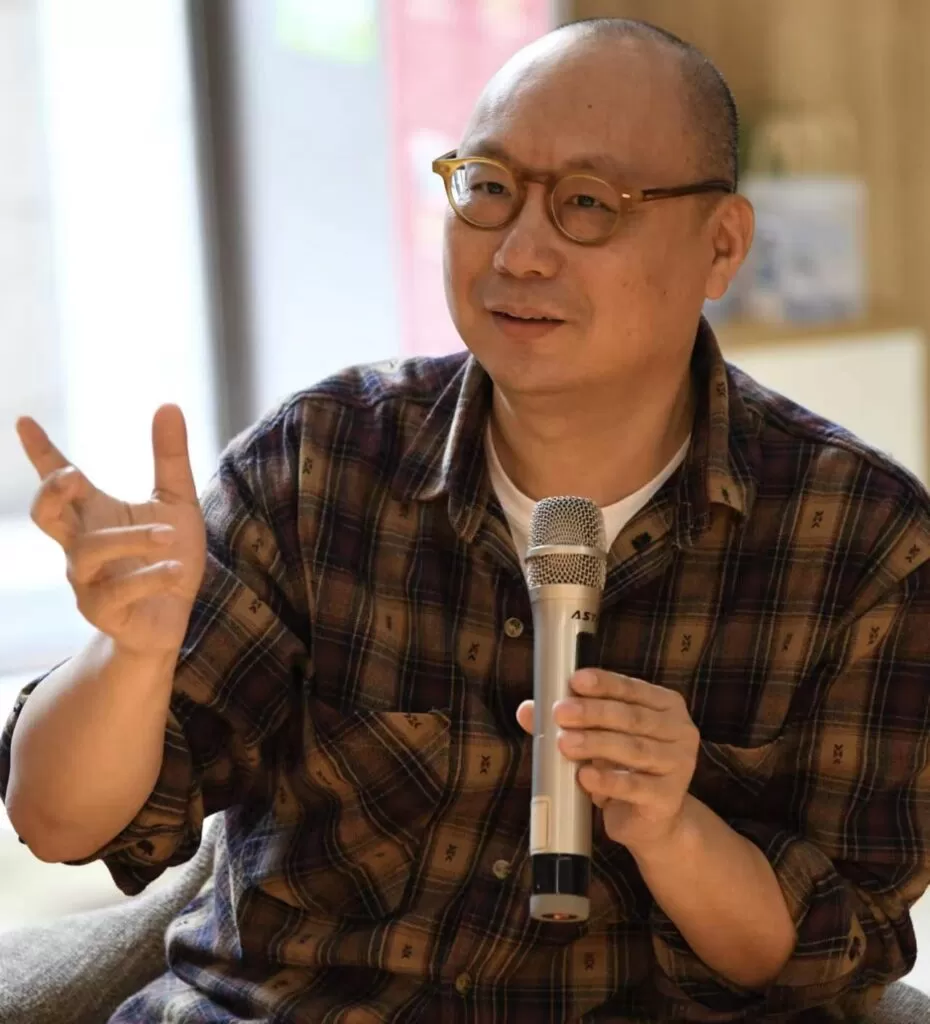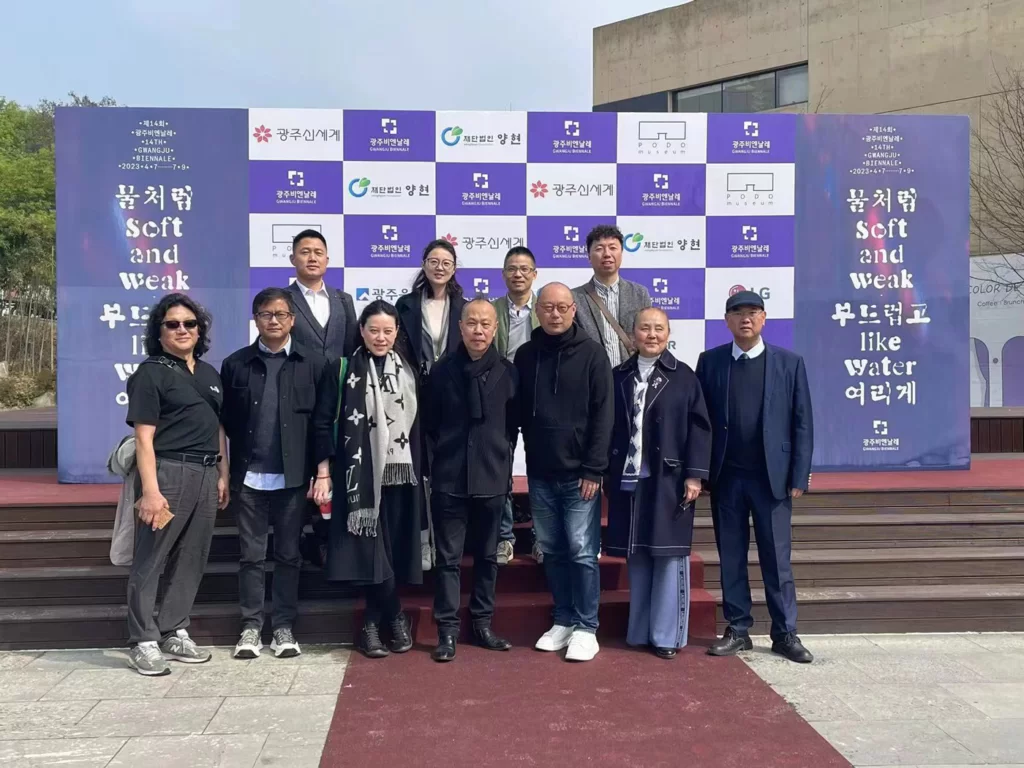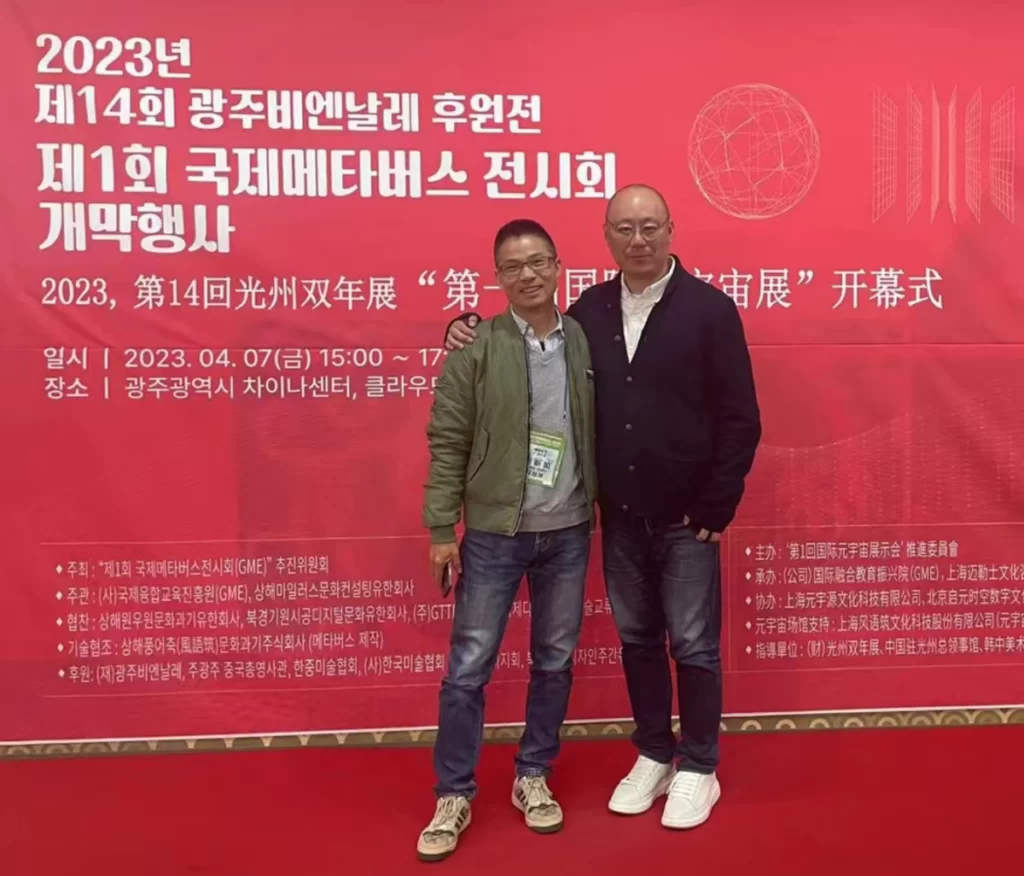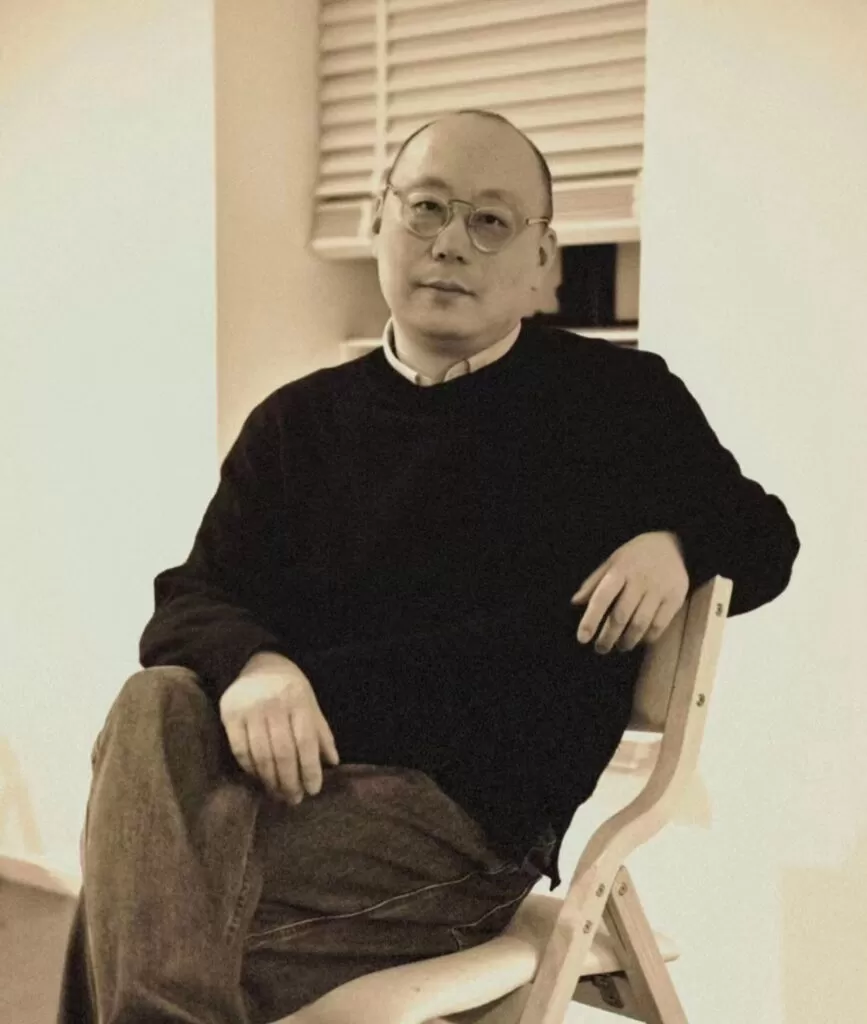Chinese curator Huang Yi navigates a fluid intersection between traditional art and its digital counterpart. Educated in the esteemed halls of Shanghai Arts & Crafts College and Shanghai University and further polished at France’s ÉCOLE D’ART ET DE CULTURE, Huang Li’s academic odyssey maps an intellectual evolution that has prepared him for the complexities of the contemporary art world.

For me, the most attractive part of art is that it can take me to observe and understand the world from the perspectives of artists
Huang Yi
His multifaceted career—from design to entrepreneurship and venture capital—has culminated in a curatorial vision bridging diverse disciplines, media, and concepts. Yi’s moment of reckoning arrived with the advent of crypto art, NFTs, and the metaverse. This digital whirlwind not only swept the West but also echoed in the sophisticated circles of China.
What sets Yi apart is his curatorial approach to what constitutes “art,” a term he dissects and reconstitutes as a shifting symbol relative to the vantage point of the observer. For him, art is not static or monolithic but a dynamically evolving entity, continuously redefined by its relationship to the “new.” This mindset opens a fresh dialogue between established art forms and emerging digital phenomena, challenging artists to expand their conceptual boundaries.
Indeed, Yi does not consider technology as a mere tool or barrier but as an existential arena where artistic cognition must be reevaluated and perhaps redefined. His poignant questions to traditional artists are both technical and philosophical; they call for a deeper rethinking of how art will exist in our increasingly digitalized parallel universe. In doing so, Yi invites us to ponder the most existential questions concerning art’s future, both virtual and tangible. I caught up with Yi to learn more about his curatorial approach and the nuances of Chinese art.
Hi Huang, Thanks for taking the time to speak with us. Can you provide some insights into your background and journey in art and curation?
Huang Yi: Hi, Len. It’s a great honour to be invited for your interview. I first graduated from Shanghai Arts & Crafts College and Shanghai University, majoring in visual communication design and advertising planning. Then I pursued further study in EAC (ÉCOLE D’ART ET DE CULTURE) in France, got the master’s degree in arts management, and was appointed as a guest tutor by the College this year.
Before pursuing a career as a curator, I once worked as a designer, company owner, VC fund partner, artistic advisor and so on. About five or six years ago, crypto art rose as a new force, followed by NFT art, metaverse art and ChatGPT art. New concepts emerged one after another and soon swept around the world. China was also affected. Such pop art got young people crazy and shocked the entire Chinese art circles. Believing that an “art revolution” storm was on the way to take the art history into a new chapter, I decided to throw myself into this historical “storm”, thus becoming a professional curator. Luckily, I was appointed as the chief curator for the First Metaverse Art Exhibition of Gwangju Biennale, and determined the theme of exhibition as “2019 – Present: Every Day”. From then on, I received much attention from the art circles both at home and abroad.
How do you see the evolution of Chinese art in the context of its long and varied history?
Huang Yi: China is an ancient country with a history of more than 3,000 years and profound cultural deposits. It is a pride for human civilization. However, such “profoundness” can also become a “heavy burden”, for we have always been limited to the traditional Chinese culture, failing to make breakthroughs. Take Chinese painting as an example.
We had always imitated the ancients and inherited the “art heritage” until the end of “the Cultural Revolution”. From then on, China’s politics has gradually headed towards reform and opening up. When we began to open up to the world, we found that great changes were taking place in art form and art style in the world.
China’s young artists began to learn from the west, which sparked a modern art revolution in China later known as the “85 New Art Trend” (85 New Art Trend refers to the art movement taking place in the Chinese mainland in middle 1980s, featuring modernism.). The arrival of information revolution, especially the birth of Internet, has turned the world into a “global village”, and also opened the world’s gate to China in real sense. The spread of new ideas has made Chinese artists’ mind more active. New technologies, such as VR/AR, blockchain technology and AI, have produced new art forms. China’s artists born from 1980 to 1989 get so excited about this, and a large number of digital artists spring up. Gradually, Chinese art has got integrated into the world art.

In what ways does contemporary Chinese art reflect, challenge, or depart from traditional artistic practices?
Huang Yi: As I mentioned before, China is a country with a long history. It is not easy to challenge the tradition. The challenge of Chinese contemporary art to traditional art is not just in art style, art form or art materials, but in thought, that is, the ideology, such as collective consciousness and individual consciousness, metaphysics and science. The conflict and update of concepts is all that matters. Contemporary art does not care about traditional aesthetics. Instead, it goes against aesthetics. What it cares about is the “ideology”.
It questions the traditional ethics and values, and all the things we take for granted. For 3,000 years, China has advocated Confucianism and been open to the cosmology of “unity between man and nature”. I think it’s not easy to question it and challenge it now. Early in the beginning of the 20th century, China launched a movement to criticize traditional culture, known to history as the “New Culture Movement”. With evolutionary perspectives and individual emancipation thought as major weapons, advocates of the Movement violently attacked the past saints and sages, represented by Confucius, vigorously promoted new morality and new literature, and strongly opposed the old morality and classical Chinese. The result was that, except the science they introduced from the west, they made no other changes.
Your curatorial practice and approach bridge both traditional and digital art. Can we delve into what this curation process looks like for you?
Huang Yi: In my opinion, “traditional art” refers to something and has different signifiers. For Renaissance art, the medieval art is traditional art. For modern art, classical art is traditional art. For contemporary art, modern art is traditional art. Therefore, the so-called “traditional art” has become a symbol, representing all the art forms showing up in the art history. The digital art symbolizes an art form that is in progress, but poses a technological barrier for traditional artists.
The development of ChatGPT can break it down for them. As a result, technology is no longer a problem. The cognition of artists is the key. When facing traditional artists, I will often ask them such questions. Do you agree that human beings are about to enter into a digitalized parallel world, that is the so-called “metaverse”? How will you build links between the real world and the virtual world? How will you show your works in the virtual world? These are the questions worth thinking about by today’s traditional artists.
How do you see the role of digital art, especially when juxtaposed against the traditional artistic medium of painting?
Huang Yi: For the audiences, the difference between digital art and painting art lies in the viewing pattern. Traditional paintings are “seen” with our eyes. For instance, Clive Bell, a British literary critic, proposed the theory of “significant form” for modern art in the late 19th century. He believed that the “form” arranged and combined in unique ways between different parts and different qualities of works was “significant” and could arouse people’s aesthetic emotion when they watched it. The way to view digital art is to “experience”. Audiences can “experience” digital works visually, aurally and tactually, a way also known as immersive art.
With information technologies such as AR/VR, a “quasi-true” phantom world is created for the audiences. Why does this art form come out? I think besides the rapid development of information technology, a cultural phenomenon in modern society should not be ignored, that is, the culture of the consumer society. Once, Baudrillard, a post-modernism master, pointed out in his work Consumer Society that modern society was an emulation society created by the mass media. As simulated and emulated things take the place of real and original things on a large scale, the world will become a simulacrum.

How do you feel digital art is fitting into the broader trajectory of Chinese art history?
Huang Yi: Frankly speaking, digital art is hardly the mainstream art in China or Asia. Currently, mainstream art is still traditional art, including easel painting, integrated material art, installation art and so on. As to digital art, China’s art circle mainly takes a wait-and-see attitude or a hesitant attitude. There are many reasons for this situation. The first one is about the concept. Traditional artists believe that traditional art is more valuable because it takes much time and more labour for them to create a piece of work. In contrast, digital art is produced by computers.
With professional software, people can turn out hundreds of pieces of works in one go, so the value of work is small. The second one is about technological barrier. Most traditional artists are post-60s and post-70s. In their times, computers were not popularized, so they mainly painted by hand. For them, it was strange to use computers as their creation tools.
Today, most digital artists are post-80s and post-90s. As they grow up in computer games, the computer is a handy tool for them. The last one is about the trading of digital artworks. For traditional collectors, traditional artworks are much easier to be collected, flaunted and displayed, thus causing a problem that traditional collectors are rarely willing to collect digital artworks. However, there is no doubt that digital art has become a tendency for future art.
In your observation, how has the rise of digital art influenced the themes and methods adopted by contemporary Chinese artists?
Huang Yi: As I mentioned, China’s traditional contemporary artists are mainly post-60s and post-70s. Due to their deep understanding of the political movements before and after the “Cultural Revolution”, they mainly theme their works on the criticism and reflection of the ideology. In contrast, the young digital artists are post-80s and post-90s and show no interest in the things about ideology.
For them, history is much too leaden; instead, the current culture is more interesting, such as cyberpunk culture and fashionable culture. At the same time, they are also fascinated by the traditional classical Chinese culture such as the Classic of Mountains and Seas, Hanfu culture, Confucian culture, Zen culture and Taoist culture. In their works, you can often see the fusion of these two kinds of culture.
The intelligent combination of Chinese culture and Western culture makes their works visually striking and provides various forms of expression such as illustration art, CG art and graffiti art. Their works are fashionable, vanward and fantastic and are spread through various social media networks in China, such as Red (Xiaohongshu, Weibo, TikTok and WeChat Group. Expressing a “cool” philosophy, these works gradually form a kind of pop culture and art favoured by young people

With the proliferation of the NFT marketplace, how has it impacted the valuation and acquisition of Chinese digital art?
Huang Yi: With the rapid popularization and development of NFTs worldwide, NFTs, a blockchain-based digital asset, provides a new way of creation and trading for digital artists. But it is a pity that it is illegal to trade NFTs in China. Chinese government explicitly states that NFTs exhibit some potential value in enriching the digital economic modes and promoting the development of cultural and creative industry, but also raises the risks of speculation, money laundering and illegal financial activities. Hence, in China, there is no such saying as NFT. It is called a digital art collection.
The major difference between the two not only lies in the name but also in the technology platform. Currently, the universal platform used in the world is the public blockchain, while that used in China is the domestic alliance chain.
This is the essential difference. Actually, there are many apps for digital collections in China. Those remain active include Topnod, Huanhe, Lingxi and Baidu’s XuperChain Digital Collections. Most of the collectors are post-90s.

Every curator has a unique process of bringing an exhibition to life. Could you walk us through yours, starting from the germination of the initial idea, choosing themes, and selecting artists right up to the open day?
Huang Yi: The definition of curator varies with times. I define the role of a curator as a director who collects opinions and views from artists and then shows them to audiences in the form of exhibition. Actually, I have always been interested in public issues such as metaphysics and science, the difference between oriental culture and Western culture, commerce and art, posthuman and so on.
I have paid much attention to them. This January, I held an exhibition about the “dialogue” between oriental culture and Western culture at Shanghai Bund 18 Art Museum. This exhibition was themed on the relationship between “human, science, technology and nature” and was titled as Fusion・Brilliant Rays. Mr. Celyn Bricker, a visual artist in the UK, and Mr. Ding She, a cross-media artist in China, were invited for this exhibition.
Why did I organize such an exhibition? Before the outbreak of the pandemic, I had always believed that with the integration of the world economy, the oriental culture and Western culture were gradually fusing with each other to form the so-called “international culture” and knew each other quite well.
However, the pandemic made me realize that it was not the case. It seemed that the two lived in two parallel worlds, knowing nothing about each other. So, I wanted to let Chinese artists and Western artists have a dialogue with their works. Luckily, the exhibition drew much attention from the public and attracted a lot of visitors. It is certain that the exhibition is a great success.
After all is said and done, on a personal note, what does art indeed mean to you?
Huang Yi: Art is a way for me to perceive the world. For me, the most attractive part of art is that it can take me to observe and understand the world from the perspectives of artists. For instance, I invited twenty digital artists from China, Korea, UK, Poland, Italy and the US to participate in 2023, The 14th Gwangju Biennale – The First Metaverse Exhibition, in which I served as the curator.
The theme of the exhibition was “2019 – Present: Every Day”, which was inspired by The Society of Spectacle, the work by Guy Debord, a French thinker and a representative of international situationism. I hope to, through this theme, learn the true opinions and true feelings of people in the world about the pandemic. I can sense and understand the truth of the event from the perspectives of different artists and can restore the true history. It feels so cool.
©2023 Huang Yi





